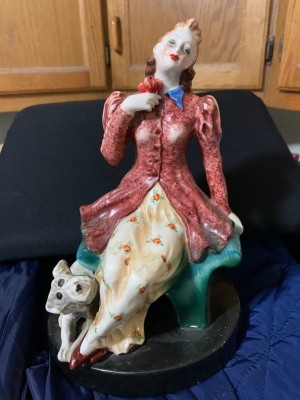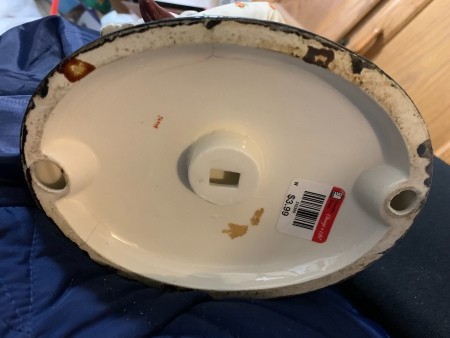 Cannot find anything in my research. Looks like an older movie star. Appreciate your help!
Cannot find anything in my research. Looks like an older movie star. Appreciate your help!

Add your voice! Click below to answer. ThriftyFun is powered by your wisdom!
The Japan mark suggests after 1952 when the term "occupied Japan" stopped being used.
The holes on the bottom suggest it was a molded piece.
The women does look like a cross between Vivian Leigh and Judy Garland (to me). The dog is odd...which I thought would make it easy to find. It is probably mass produced--I was at first thinking it was a ceramics class piece until I saw the Japan marking.
Dog figurines are always popular. Maybe just list it as a vintage woman figurine with dog marked Japan and let the market dictate the value.
Post back what you decide!
The mark "JAPAN" was used not only in 1952-today - POST-WAR MADE IN JAPAN ERA, but also in 1921-1941 EARLY MADE IN JAPAN ERA ("GOLDEN AGE"). The U.S. Customs Bureau ruled that "Nippon" was no longer an acceptable synonym. As of August 1, 1921 all goods were supposed to be backstamped "JAPAN". Unmarked pieces sometimes slipped through Customs, but most of the Japanese ceramics from 1921 to 1941 are marked either "JAPAN" or "MADE IN JAPAN".
It is going to be very hard to identify this piece, as there is no manufacturers mark on it.
I have looked at this piece several times and I'll have to say that that is the weirdest looking dog that I've ever seen.
I know it is a molded piece but difficult to be believe it was mass produced in this same form.
I wish that you would join Reddit and place this on their site as their members just love to try and identify items like this.
Reddit is a little difficult to use as a new member but you can always ask question if you have problems.
Be sure to mention the weird dog... and size of item.
www.reddit.com/
Please let us know what you find out.
Add your voice! Click below to answer. ThriftyFun is powered by your wisdom!